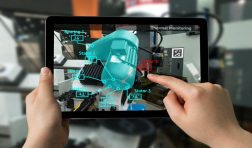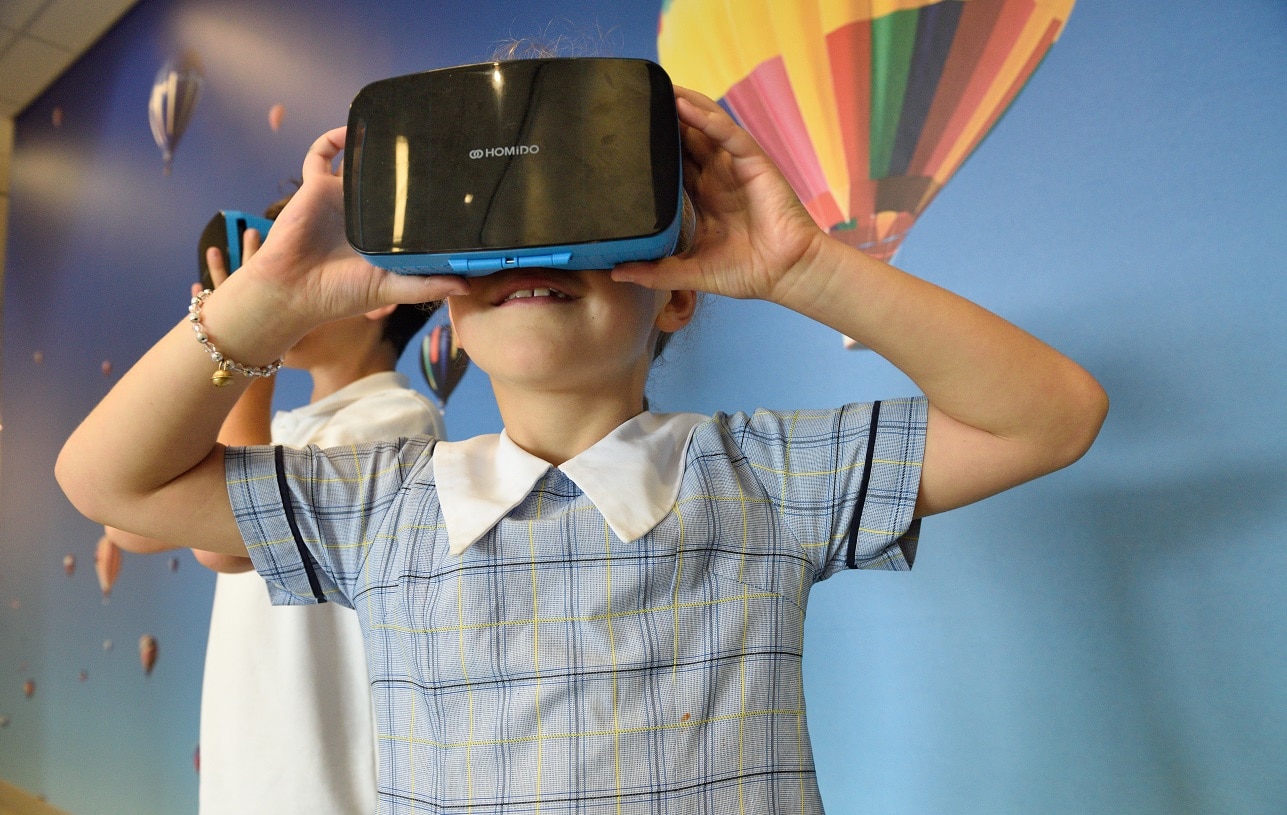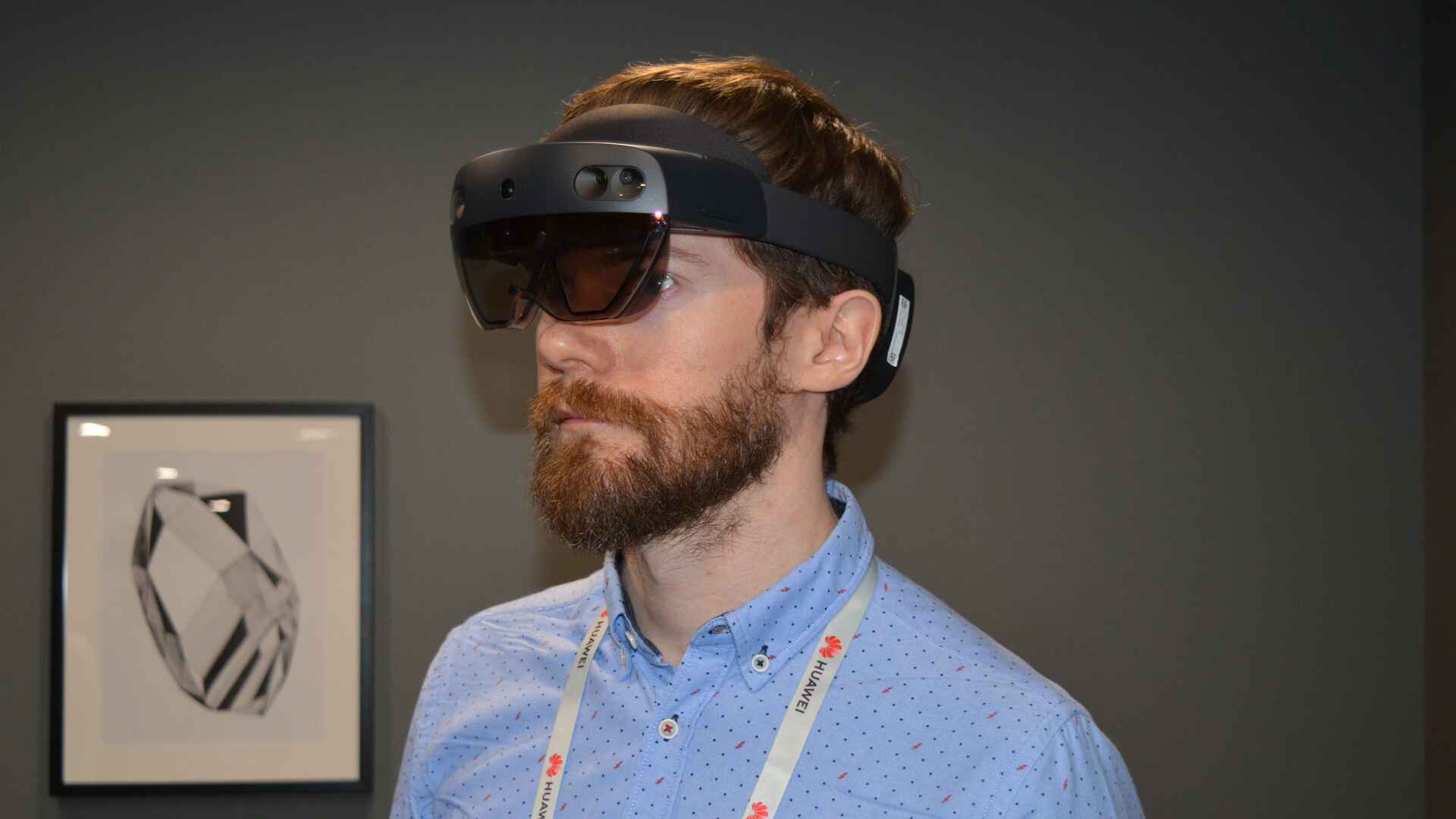What is Augmented Reality?
Augmented Reality (AR) is a technology that blends virtual elements with the real world, creating an enhanced and interactive experience for users. Unlike virtual reality, which immerses users in a completely simulated environment, augmented reality overlays virtual objects onto the existing physical environment.
AR utilizes various technologies such as computer vision, sensors, and graphics to overlay digital information onto real-world objects, enhancing the user’s perception and interaction with their surroundings. This can be achieved through a variety of devices, including smartphones, tablets, smart glasses, and headsets.
The key distinction of augmented reality is its ability to seamlessly integrate virtual elements into the real world, allowing users to interact with both worlds simultaneously. This opens up a myriad of possibilities across various industries, including business, education, entertainment, healthcare, and more.
By using specially designed applications or software, AR can bring static images, videos, animations, and 3D models to life. For example, while visiting a museum, an AR app can provide additional contextual information about the exhibits by overlaying text, images, or videos directly on the device’s screen. In the retail sector, AR can enable customers to visualize how furniture or clothing items would look in their own space before making a purchase.
AR has become increasingly popular thanks to its ability to enhance user experiences and provide valuable information in real-time. As the technology continues to evolve, the potential applications of augmented reality are virtually limitless. From enhancing training and education to revolutionizing the way we shop, work, and communicate, AR is changing the way we perceive and interact with our environment.
History of Augmented Reality
The concept of augmented reality traces its roots back to the 1960s when computer scientist Ivan Sutherland introduced the concept of a head-mounted display (HMD) that could overlay digital graphics onto the real world. However, it wasn’t until the 1990s that the term “augmented reality” was coined by Tom Caudell, a researcher at Boeing. Since then, AR has evolved rapidly, driven by advancements in technology and a growing demand for immersive and interactive experiences.
One of the key milestones in the history of augmented reality was the development of the ARToolKit in the late 1990s. Created by Hirokazu Kato, this open-source software library enabled the tracking of markers in real-time, allowing virtual images to be precisely aligned with physical objects. This breakthrough paved the way for the widespread adoption of AR in various industries.
In the early 2000s, AR gained attention in the gaming world with the release of the ARQuake game, a modified version of the popular first-person shooter game Quake. ARQuake used a head-tracked display and a handheld marker to create a mixed reality experience, where players could see virtual monsters overlaid onto their real environment.
Fast forward to 2013, and Google introduced Google Glass, a wearable AR device that sparked significant interest and excitement. Although Google Glass did not achieve mass-market success, it served as a catalyst for further innovations in the AR space, inspiring other companies to explore the possibilities of AR glasses.
Another significant milestone in the history of augmented reality was the launch of Pokémon Go in 2016. This mobile game captivated millions of players worldwide and showcased the potential of AR for mainstream applications. Pokémon Go integrated virtual creatures into the real world, leading people to explore their surroundings and interact with virtual objects in an unprecedented way.
Today, we see augmented reality being utilized in various industries, from ecommerce and advertising to healthcare and education. Companies like Microsoft with its HoloLens and Apple with its ARKit are pushing the boundaries of AR hardware and software, making the technology more accessible and user-friendly.
The history of augmented reality is a testament to the power of human imagination and technological advancements. As AR continues to evolve, we can expect it to become an integral part of our daily lives, transforming the way we work, play, and connect with the world around us.
How Does Augmented Reality Work?
Augmented reality technology works by combining real-world sensory information with computer-generated content to create an enhanced and interactive user experience. To understand how augmented reality works, let’s take a closer look at the key components and processes involved:
Sensors: Augmented reality relies on various sensors to gather real-time information about the physical environment. These sensors can include cameras, GPS, accelerometers, gyroscopes, and depth sensors. They capture data such as the user’s location, movement, and orientation, which is then used to align virtual content with the real world.
Computer Vision: Computer vision algorithms analyze the sensory data obtained from the sensors to identify and track objects and surfaces in the real world. This allows the augmented reality system to understand the user’s environment and accurately place virtual content in the desired location.
Content Rendering: Once the virtual content is aligned with the real world, it needs to be rendered and displayed to the user. This is done through various types of displays, such as smartphones, tablets, smart glasses, or headsets. The virtual content can range from simple 2D images and text to complex 3D models and animations.
Overlay and Interaction: The virtual content is superimposed onto the real environment, creating the augmented reality experience. Users can interact with the virtual objects using gestures, voice commands, or touch inputs, depending on the device and application. For example, users can tap on a virtual button displayed on their smartphone screen or use hand gestures to manipulate virtual objects seen through a pair of smart glasses.
Real-Time Updates: Augmented reality systems constantly update the virtual content based on the user’s movements and changes in the real environment. This ensures that the virtual objects remain aligned and accurately positioned, providing a seamless and immersive experience.
It’s important to note that augmented reality can be marker-based or markerless. Marker-based AR uses predefined markers or objects as reference points for anchoring virtual content. These markers can be images, QR codes, or physical objects. Markerless AR, on the other hand, relies on computer vision and sensor data to detect and track surfaces and objects in the real world without the need for markers.
Overall, augmented reality works by integrating real-world sensory information, computer vision algorithms, content rendering, and user interaction to create a blended reality experience. As the technology continues to advance, we can expect more sophisticated and immersive augmented reality experiences to become a part of our daily lives.
The Importance of Augmented Reality in the Business World
Augmented reality (AR) has gained significant importance in the business world due to its ability to revolutionize the way companies engage with customers, improve productivity, and drive innovation. Here are some key reasons why augmented reality is crucial for businesses:
Enhanced Product Visualization: AR allows businesses to showcase their products in a more interactive and immersive way. Customers can use AR applications to visualize how products would look or fit in their own environment before making a purchase. This improves customer confidence and reduces the chances of returns or dissatisfaction.
Virtual Try-On and Personalization: AR technology enables customers to virtually try on clothing, accessories, and even cosmetics. This not only enhances the shopping experience but also saves time and reduces the need for physical fitting rooms. Additionally, AR can help businesses personalize products and services, allowing customers to customize their options and see real-time adjustments.
Improved Training and Remote Collaboration: AR has immense potential for training employees by providing interactive and immersive experiences. It can simulate real-life scenarios, allowing employees to practice and learn in a safe and controlled environment. AR also facilitates remote collaboration, enabling teams to share live AR views and provide instructions or guidance in real-time.
Streamlined Maintenance and Repairs: Augmented reality can enhance the efficiency and accuracy of maintenance and repairs. Technicians can wear AR glasses or use mobile AR applications to access digital manuals, overlay instructions onto physical equipment, and receive real-time guidance. This reduces downtime, minimizes errors, and improves overall productivity.
Marketing and Advertising Opportunities: AR provides businesses with creative marketing and advertising opportunities. Brands can engage customers through interactive AR campaigns, enabling them to view digital content, play games, or unlock special offers by scanning AR codes or markers. This helps businesses stand out, capture attention, and create memorable experiences.
Data Visualization and Analytics: Augmented reality can transform complex data into visual representations, making it easier for businesses to analyze and interpret information. AR dashboards and overlays can display real-time data, performance metrics, and insights, empowering businesses to make informed decisions and take appropriate actions.
Competitive Advantage: By embracing augmented reality, businesses can gain a competitive edge in the market. AR can differentiate products and services, enhance customer satisfaction, improve efficiency, and drive innovation. Being at the forefront of AR adoption can position businesses as industry leaders and help them attract and retain customers.
Overall, augmented reality is of utmost importance in the business world as it opens doors to new possibilities, improves customer engagement, streamlines operations, and drives growth. By embracing and harnessing the power of AR, businesses can stay ahead of the curve and thrive in an increasingly digital and immersive marketplace.
Augmented Reality in Education and Training
Augmented reality (AR) has the potential to revolutionize education and training by providing immersive and interactive learning experiences. It offers a wide range of benefits that can enhance student engagement, facilitate knowledge retention, and improve practical skills. Here are some key ways in which augmented reality is transforming education and training:
Visualizing Complex Concepts: AR can help students visualize complex concepts that are difficult to understand through traditional teaching methods. By overlaying 3D models, animations, or simulations onto textbooks or real-world objects, AR brings abstract concepts to life and makes learning more interactive and engaging.
Enhancing Practical Skills: AR provides a virtual environment where students can practice and refine practical skills. For example, medical students can use AR to simulate surgeries, allowing them to gain hands-on experience before operating on real patients. Similarly, engineering students can use AR to design and test prototypes, improving their problem-solving and critical thinking abilities.
Virtual Field Trips: With AR, students can go on virtual field trips without leaving the classroom. AR applications can transport students to historical locations, famous landmarks, or even outer space, allowing them to explore and learn in a more immersive and interactive way. This opens up new possibilities for experiential learning and broadens students’ horizons.
Language Learning: AR can enhance language learning by providing real-time translations, vocabulary overlays, and interactive language exercises. Students can use AR apps to scan text or objects and receive instant translations or explanations. This makes language learning more engaging and practical, allowing students to apply their knowledge in real-life contexts.
Personalized Learning: AR can adapt to the individual needs and learning styles of students. By analyzing students’ progress, AR applications can provide personalized feedback, recommendations, and additional resources. This fosters independent and self-paced learning, ensuring that each student receives tailored support and guidance.
Collaborative Learning: AR facilitates collaborative learning experiences by allowing students to interact with virtual objects or participate in shared AR simulations. Whether it’s solving puzzles together, conducting virtual experiments, or collaborating on design projects, AR encourages teamwork, communication, and problem-solving skills.
Accessibility and Inclusion: AR can make education more inclusive and accessible for students with disabilities. For example, students with visual impairments can use AR to receive audio descriptions or haptic feedback, enabling them to engage with the content in a meaningful way. AR also supports diverse learning styles, catering to auditory, visual, and kinesthetic learners.
Augmented reality has the power to transform education and training, making learning more engaging, immersive, and effective. As the technology continues to advance, we can expect to see even more innovative and impactful applications of AR in classrooms and training environments.
Augmented Reality in Entertainment and Gaming
Augmented reality (AR) has significantly impacted the entertainment and gaming industry, offering immersive and interactive experiences that blur the line between the virtual and real world. AR has transformed the way people engage with entertainment content and has opened up new opportunities for creativity and engagement. Here are some key ways in which augmented reality is revolutionizing entertainment and gaming:
Interactive Gaming: AR has brought gaming to a whole new level by merging virtual elements with the real world. Mobile AR games like Pokémon Go and Harry Potter: Wizards Unite have captivated millions of players worldwide, encouraging them to explore their surroundings and interact with virtual objects. This interactive and location-based experience has transformed the way people play games, fostering social interaction and physical activity.
Live Events and Performances: AR is being utilized in live events and performances to provide a visually stunning and immersive experience for the audience. Through AR overlays and projections, concerts, sports events, and even theater productions can create dynamic and interactive visual effects that enhance the overall experience. AR also allows for real-time data and statistics to be displayed during sporting events, adding an extra layer of engagement for spectators.
Virtual Reality Experiences: AR technology can be combined with virtual reality (VR) to create mixed reality experiences that allow users to interact with virtual objects while being fully immersed in a virtual environment. This combination opens up endless possibilities for immersive storytelling, interactive simulations, and realistic gaming experiences.
Advertising and Promotions: AR has transformed the way brands and advertisers engage with consumers. AR advertising campaigns allow users to interact with virtual objects and characters, providing a unique and memorable consumer experience. For example, AR try-on experiences in the beauty and fashion industry allow customers to virtually try on makeup or clothing before making a purchase.
Theme Parks and Attractions: AR has enhanced theme park experiences by adding layers of interactivity to attractions. Visitors can use AR-enabled devices or special glasses to see virtual characters or objects overlaid onto real-world settings, creating an immersive and magical experience. Interactive AR elements can also be incorporated into museum exhibits, art installations, and other cultural attractions.
Storytelling and Media: AR is transforming traditional storytelling mediums such as books, movies, and TV shows by overlaying additional digital content onto the physical media. This provides a richer and more interactive storytelling experience. AR-enhanced books, for example, can bring characters and scenes to life, allowing readers to engage with the story in a whole new way.
Augmented reality is changing the entertainment and gaming landscape by providing immersive, interactive, and engaging experiences. As technology continues to advance, we can expect AR to play an even more significant role in how we consume entertainment and engage with virtual worlds.
The Benefits of Augmented Reality in Healthcare
Augmented reality (AR) has immense potential to transform healthcare by providing innovative solutions that improve patient care, enhance medical training, and streamline healthcare processes. Here are some key benefits of augmented reality in healthcare:
Enhanced Visualization and Imaging: AR can improve the visualization of medical images and data. Surgeons can use AR overlays during operations to accurately visualize and locate structures, improving precision and reducing the risk of errors. AR can also assist in interpreting complex medical scans and displaying real-time patient data, making it easier for healthcare professionals to make informed decisions.
Surgical Planning and Navigation: AR can aid in surgical planning by superimposing 3D models onto the patient’s anatomy, allowing surgeons to better understand complex anatomical structures and plan procedures more accurately. During surgery, AR can provide real-time guidance and navigation, overlaying important information such as blood vessels or tumor boundaries directly onto the surgeon’s field of view.
Medical Training and Education: AR can revolutionize medical training by providing immersive and interactive simulations. Medical students and professionals can practice procedures or learn anatomy through AR simulations. This enhances learning experiences, allows for repeated practice in a risk-free environment, and helps bridge the gap between theory and practical skills.
Patient Education and Engagement: AR can improve patient education by providing visual and interactive explanations of medical conditions or treatment options. Patients can better understand their diagnoses and be actively involved in decision-making. For example, AR can show how medications interact with the body or demonstrate the progression of a disease, enabling patients to make informed choices about their healthcare.
Pain Management and Rehabilitation: AR can help manage pain and aid in rehabilitation. By providing immersive and engaging distractions, AR can reduce the perception of pain and discomfort during medical procedures. AR-based rehabilitation exercises can also assist in improving motor skills and facilitating recovery for patients undergoing physical therapy.
Remote Assistance and Telemedicine: AR can enable remote healthcare delivery by providing real-time assistance and guidance to healthcare professionals. Through AR-enabled devices, clinicians can remotely monitor patients, visualize patient data, and provide instructions or consultations. This is especially valuable in rural or underserved areas where access to specialized care may be limited.
Efficiency and Workflow Improvement: AR can streamline healthcare processes and improve workflow efficiency. For example, AR overlays can display patient information, electronic records, or medication details directly in the clinician’s field of view, reducing the need to shift attention to separate devices. This improves accuracy, saves time, and allows healthcare professionals to focus more on patient care.
Augmented reality has the potential to transform healthcare by improving visualization, enhancing medical training, empowering patients, and optimizing healthcare processes. As AR technology continues to advance, we can expect even more innovative applications that will revolutionize the delivery of healthcare services.
Augmented Reality in Architecture and Design
Augmented reality (AR) has emerged as a powerful tool in the field of architecture and design, revolutionizing the way professionals visualize and communicate their ideas. AR offers a range of benefits that enhance design processes, improve client engagement, and streamline project implementation. Here are some key ways in which augmented reality is transforming architecture and design:
Visualization and Conceptualization: AR allows architects and designers to visualize and present their ideas in a more immersive and interactive manner. By overlaying digital models onto the real environment, AR enables stakeholders to experience and understand spatial layouts, material selections, and design concepts in a more realistic and engaging way. This enhances communication and helps clients better visualize the end result.
Real-Time Design Iteration: AR enables architects and designers to make real-time design iterations and adjustments. With AR glasses or smartphones, professionals can visualize design changes in real-time, overlaying virtual elements onto the physical space. This facilitates quick decision-making, reduces the need for physical prototypes, and accelerates the design iteration process.
Collaborative Design and Review: AR enhances collaboration among design teams and stakeholders. Multiple individuals can view and interact with virtual elements simultaneously, regardless of their physical location. This enables real-time design reviews, feedback sharing, and efficient collaboration throughout the design and construction phases.
On-Site Visualization and Construction: AR facilitates on-site visualization during construction and renovation projects. Contractors and workers can use AR-enabled devices to overlay digital models onto the physical site, ensuring accurate alignment and placement of building components. This minimizes errors, aligns construction with design intent, and improves construction efficiency.
Energy Analysis and Sustainability: AR can aid in energy analysis and sustainability assessments. By overlaying thermal and lighting simulations onto the physical environment, architects and designers can evaluate energy consumption, identify areas for improved efficiency, and optimize sustainable design strategies. AR enhances the decision-making process by providing visual insights into the impact of design choices on energy performance.
Historical Preservation and Restoration: AR helps in preserving and restoring historical structures. By overlaying historical images and information onto physical sites, AR can recreate historical environments and provide virtual tours of significant landmarks. This allows for the preservation of cultural heritage, educating and engaging visitors in a dynamic and immersive way.
Interior Design and Furniture Placement: AR enables interior designers and homeowners to digitally visualize and arrange furniture and decor within a space. By overlaying virtual furniture and accessories onto the physical environment, AR allows for real-time visualization and experimentation with different layouts, styles, and color schemes. This helps in making informed decisions and achieving optimal interior designs.
Augmented reality is transforming architecture and design by providing immersive visualization, enhancing collaboration, and streamlining project implementation. As AR technology advances, it will continue to shape the future of the industry, empowering professionals to create innovative and impactful designs.
Augmented Reality in Tourism and Travel
Augmented reality (AR) has emerged as a game-changer in the tourism and travel industry, enhancing the overall visitor experience and revolutionizing the way people explore and engage with new destinations. AR offers a wide range of benefits that transform travel experiences, provide valuable information, and make travel more interactive and engaging. Here are some key ways in which augmented reality is impacting tourism and travel:
Virtual Tours and Destination Previews: AR allows travelers to take virtual tours and previews of destinations, providing a glimpse of what to expect before making travel plans. By overlaying digital content onto physical surroundings, AR apps can showcase popular landmarks, attractions, historical sites, and hotels, helping travelers make informed decisions.
Real-Time Information and Navigation: AR apps can provide real-time information and navigation assistance to travelers. By overlaying directions, local points of interest, and helpful tips onto the real world, AR apps enhance travelers’ ability to navigate unfamiliar environments and discover hidden gems. This makes travel more convenient and reduces the reliance on traditional maps and guidebooks.
Cultural and Historical Context: AR can provide travelers with rich cultural and historical context about their surroundings. By overlaying information, historical facts, stories, and virtual guides onto physical sites, AR apps can enhance travelers’ understanding and appreciation of the places they visit, creating a more immersive and educational experience.
Language Translation and Interpretation: AR technology can assist travelers in overcoming language barriers. By using image recognition and real-time translation, AR apps can translate signs, menus, and other text in real-time, helping travelers communicate and navigate in foreign countries. This enhances the overall travel experience and fosters cultural exchange.
Entertainment and Interactive Experiences: AR offers interactive and entertaining experiences for travelers. AR apps can overlay virtual characters, games, and animations onto physical environments, providing unique and engaging activities and attractions. This creates memorable experiences and encourages travelers to actively participate in their surroundings.
Personalized Recommendations: AR can deliver personalized recommendations and suggestions based on travelers’ preferences and interests. By analyzing user data and location context, AR apps can recommend nearby attractions, restaurants, and activities that align with travelers’ preferences. This helps travelers discover new experiences and tailor their trips to their individual preferences.
Enhanced Museum and Exhibition Experiences: AR extends the possibilities of museum and exhibition experiences. AR apps can overlay additional content, information, and interactive elements onto exhibits, making them more engaging and informative. Visitors can delve deeper into exhibits, view 3D reconstructions, access multimedia content, and participate in interactive games and quizzes.
Virtual Souvenirs and Memories: AR can create unique virtual souvenirs and memories for travelers. By allowing users to capture AR moments and overlay digital content onto their photos or videos, AR apps enable travelers to preserve and share their travel experiences in a more creative and immersive way.
Augmented reality is transforming the tourism and travel industry by providing interactive, informative, and engaging experiences for travelers. As AR technology continues to evolve, we can expect even more innovative applications that will redefine how we explore and connect with the world.
Ethical Considerations and Potential Challenges of Augmented Reality
While augmented reality (AR) offers tremendous potential and exciting opportunities, it also raises important ethical considerations and potential challenges that need to be addressed. As AR becomes increasingly integrated into our lives, it’s crucial to maintain a balance between innovation and responsible usage. Here are some key ethical considerations and potential challenges of augmented reality:
Privacy and Data Security: AR relies heavily on data collection and processing. This raises concerns about the privacy of personal information and the security of user data. As AR applications gather and analyze data from users’ surroundings, there is a need for robust privacy policies, secure data storage, and transparent data use. Striking a balance between personalized experiences and protecting user privacy is crucial.
Physical and Psychological Impact: AR can have physical and psychological impacts on individuals. Extended use of AR devices, such as headsets or glasses, may cause discomfort or fatigue. Over-reliance on AR technology may also lead to psychological effects, such as addiction or a disconnection from the real world. It is important to consider the potential physical and psychological consequences and ensure that AR usage is safe and beneficial for users.
Digital Divide and Accessibility: The adoption of AR may exacerbate existing inequalities and create a digital divide. Access to AR-enabled devices and high-speed internet connections may be limited in certain regions or among marginalized communities. Ensuring equal access to AR technology and content is essential to prevent a widening digital divide and ensure inclusivity.
Ethical Use of AR in Advertising and Marketing: AR has the potential to transform advertising and marketing practices. However, it is important to establish ethical guidelines to prevent intrusive or deceptive AR advertising. Striking a balance between delivering engaging experiences and respecting user consent and preferences is crucial. AR should be used responsibly and transparently to avoid exploitative practices or manipulative messaging.
Impact on Social Interactions and Relationships: The integration of AR into social interactions may affect the dynamics of human relationships. Overreliance on AR devices may lead to decreased face-to-face interactions and a lack of real-world connections. It is important to find a balance between the benefits of AR-enhanced interactions and maintaining genuine human connections and social bonds.
Legal and Ethical Implications in Augmented Reality Content Creation: The creation and distribution of AR content can raise legal and ethical challenges. Copyright infringement, intellectual property rights, and the potential for inappropriate or harmful content creation are important considerations. Establishing guidelines and regulations for AR content creators, ensuring responsible content distribution, and protecting the rights of content creators are crucial steps.
Bias and Discrimination in AR Algorithms and Content: AR applications and algorithms may inadvertently perpetuate biases or discriminatory practices. For example, facial recognition algorithms in AR may have biases against certain ethnicities. It is important to develop and train AR algorithms in an unbiased and inclusive manner to avoid discrimination and promote equal access and representation.
Addressing these ethical considerations and potential challenges will be essential in maximizing the benefits of augmented reality while mitigating any negative impact. Striving for responsible implementation, transparent policies, and continuous monitoring and adaptation will ensure that AR technology is used ethically and safeguards the well-being of individuals and society as a whole.
The Future of Augmented Reality
The future of augmented reality (AR) holds immense potential for innovation, transformation, and widespread adoption. As AR technology continues to advance and evolve, we can expect to see exciting developments and new applications in various industries and aspects of our lives.
Advancements in Hardware: The development of more powerful and lightweight AR devices will drive the widespread adoption of AR technology. We can anticipate the emergence of sleeker and more comfortable smart glasses, contact lenses, and even AR-enabled implants. These advancements will enhance user experiences and make AR more seamlessly integrated into our daily lives.
Integration into Smart Cities: AR will play a significant role in the development of smart cities. By overlaying digital information onto the physical environment, AR can provide real-time updates on transportation, navigation, and city services. AR can also enable immersive cultural experiences, virtual tours, and interactive displays, enhancing the overall urban experience for residents and visitors.
Immersive Entertainment Experiences: The future of AR in entertainment and gaming holds limitless possibilities. We can expect increasingly immersive and interactive experiences with virtual characters, multiplayer AR games, and mixed reality simulations. These experiences will blur the lines between the digital and physical worlds, allowing users to fully immerse themselves in captivating virtual environments.
Major Advancements in Education and Training: Augmented reality will continue to revolutionize education and training. The incorporation of AR into classrooms and training programs will provide more engaging and personalized learning experiences. AR will offer interactive simulations, virtual laboratories, and remote collaboration opportunities, transforming how knowledge is accessed and skills are developed.
Enhanced Healthcare Applications: AR will play a crucial role in healthcare, revolutionizing patient care, medical training, and telemedicine. Surgeons will utilize AR in surgical planning and real-time guidance, enhancing precision and efficiency. AR will enable remote healthcare services, connecting patients with doctors and specialists in real-time. Furthermore, AR will assist in remote monitoring, personalized rehabilitation, and mental health support.
Consumer Retail and E-Commerce: AR will redefine the consumer retail experience, both online and offline. Augmented reality will allow customers to virtually try on clothes, preview furniture in their homes, and visualize cosmetic enhancements before making purchases. As AR technologies improve, retailers will increasingly leverage AR to customize shopping experiences, enhance product discovery, and offer personalized recommendations.
Expanded Industrial and Enterprise Applications: AR will continue to transform industrial processes and enterprise applications. In manufacturing, AR will facilitate interactive assembly instructions, remote maintenance support, and quality control. In architecture and construction, AR will streamline design reviews, building inspections, and project management. Various other industries, such as logistics, field services, and automotive, will utilize AR for improved efficiency, productivity, and safety.
Integration with Internet of Things (IoT) and Artificial Intelligence (AI): AR will synergize with IoT and AI technologies, creating more seamless and intelligent experiences. Through interconnected devices and machine learning capabilities, AR will enhance contextual understanding, predictive analysis, and adaptive user interfaces. This integration will enable personalized and context-aware AR experiences, further improving efficiency and decision-making processes.
The future of augmented reality is a dynamic and exciting landscape full of endless possibilities. As AR continues to evolve and expand its applications, it will undoubtedly reshape various industries, revolutionize daily experiences, and provide us with new ways of interacting with the world around us.









